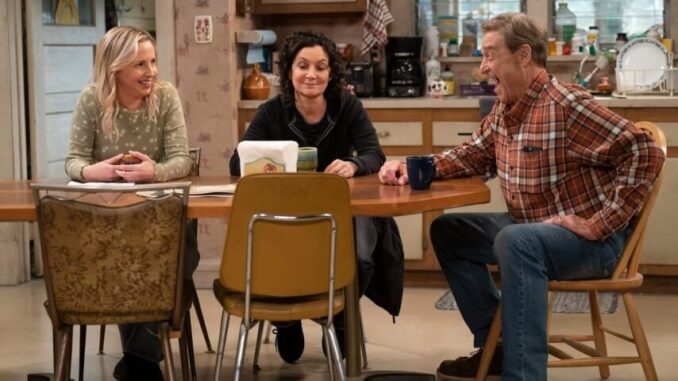
The Roseanne sitcom, which debuted in 1988, became an iconic show by presenting a raw, humorous, and often heart-wrenching portrayal of a working-class family. Decades later, The Conners emerged as a spinoff, bringing new dimensions to the story of the Conner family while moving on without its titular character. Though both shows center on the same family and tackle similar themes, Roseanne and The Conners have distinct differences in tone, focus, and approach. Let’s explore how these two series evolved and unpack the changes between them.
The Shift in Focus: From Roseanne to the Conner Family
Roseanne was always centered around Roseanne Barr’s character, Roseanne Conner, as the family matriarch. The show revolved around her wit, her sarcastic take on life, and her ability to hold her family together despite financial and personal hardships. She was the heart of the show, and much of the plotlines focused on her relationships with her husband, Dan, and her children.
When The Conners premiered after Roseanne Barr’s exit from the franchise in 2018, it became a true ensemble show. Without the matriarch, other family members—especially Dan, Darlene, and Becky—took on larger roles. The show began to explore the dynamics between the siblings and their relationships with their own children, moving away from a singular point of view to a broader family perspective. Darlene (Sara Gilbert) essentially stepped into the role of the family leader, but the show became more democratic in how it gave space to all characters.
Tone and Humor: From Edgy Satire to Subdued Reflection
One of the key elements that made Roseanne stand out in the late 1980s and ’90s was its biting humor and unapologetic social commentary. The show wasn’t afraid to tackle tough subjects like unemployment, teen pregnancy, domestic violence, and political division, often with Roseanne’s sharp, sarcastic wit driving the humor. The comedy had an edge, blending real-world struggles with dark humor and relatability.
The Conners, while still funny, has a more subdued tone. Without Roseanne’s voice anchoring the humor, the show leans into a softer, more reflective type of comedy. The characters are older, dealing with different life challenges—Darlene’s struggle as a single mother, Dan’s loneliness as a widower, and Becky’s battle with alcoholism. The humor feels less rebellious and more rooted in the emotional growth of the characters. While the political and social commentary is still present, it’s less overt and less confrontational than it was in Roseanne.
Themes: Generational Struggles and Societal Change
While both shows are steeped in the struggles of working-class life, The Conners brings new themes to the forefront, reflecting the changing times. In Roseanne, much of the conflict revolved around financial hardships, parenting challenges, and navigating family relationships. These themes remain, but in The Conners, there is a stronger focus on the intergenerational conflicts and societal shifts of the 21st century.
The Conners delves deeper into modern-day issues such as mental health, the opioid crisis, and the changing landscape of the American dream. Darlene’s challenges of raising kids in a precarious job market echo many of the struggles of contemporary parents. Meanwhile, characters like Harris (Darlene’s daughter) highlight the differences between Gen Z and older generations, with debates around technology, activism, and changing cultural values playing a more prominent role.
Absence of Roseanne Barr: A Defining Factor
Perhaps the most defining difference between the two shows is the absence of Roseanne Barr herself. Her sudden exit from the show after making controversial remarks left a huge gap in The Conners, and the writers made the bold decision to kill off her character. The aftermath of Roseanne’s death becomes a central theme in the first season of The Conners, where the family grapples with loss, grief, and finding a new sense of normalcy.
This absence, while felt, also allowed the series to explore new character dynamics. Dan (John Goodman) evolves as a character, moving from his role as Roseanne’s loving but often gruff husband to a father and grandfather figuring out how to live on his own. Without Roseanne, the other family members—particularly Darlene, Becky, and Jackie (Laurie Metcalf)—step into more prominent roles, each bringing their own set of challenges and growth to the forefront.
Cultural Impact: Nostalgia vs. Modern Relevance
Roseanne was a trailblazer in its time, providing representation for working-class Americans in a way that hadn’t been seen before on TV. It resonated with audiences because it wasn’t polished or idealized—it was raw and honest. The revival in 2018 was fueled by nostalgia, with fans excited to see the Conner family again and revisit the themes and struggles they had grown up watching.
The Conners, however, feels more like a contemporary dramedy. It’s less about revisiting the past and more about addressing the challenges that families face today. In some ways, it lacks the rebellious spirit of the original show, but it’s also more sensitive to modern issues. The characters have evolved, the world has changed, and The Conners reflects that with a more nuanced and empathetic approach.
Conclusion: Two Shows, One Legacy
In comparing Roseanne and The Conners, it’s clear that both shows share the same DNA but have taken different paths. Roseanne was groundbreaking in its depiction of the working class and its fearless humor, while The Conners has shifted to a more ensemble-driven narrative that focuses on emotional growth and adaptation to modern-day struggles. Together, these two shows offer a complete picture of the Conner family’s journey, showing how they’ve evolved through the years while still staying true to their roots.
